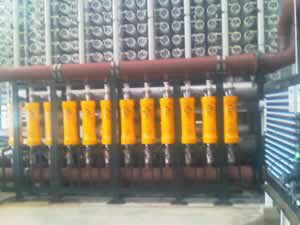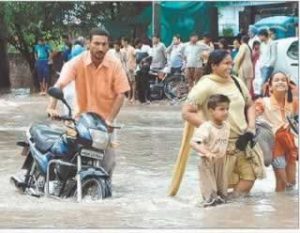Watch “बुंदेलखंड की जल धरोहरों पर साफिया खान से बातचीत, ARVIND, RSTV” on YouTube

Safia Khan has done tremendous work in the area of Bundelkhand heritage and Environment. Here she discusses how ancient Water bodies can be revitalized or restored

Safia Khan has done tremendous work in the area of Bundelkhand heritage and Environment. Here she discusses how ancient Water bodies can be revitalized or restored

The question regarding Indian cities is whether they will metamorphose into a butterflies or ugly moths !
India is urbanizing, not at a trot or a canter, but at a gallop. Urban populations are beginning to overtake rural populations in some states. In 1991 the number of urban settlements were 3768 whereas in 2001 the numbers had gone up to 4378 and which have almost doubled to 7935 in the 2011 census. The dizzying urban explosion has overwhelmed natural resources and financial resources as well as the receding countryside.
Weak urban departments are at their wits end to come up with planning solutions. Feeble enforcement agencies are unable to prevent the distortion of elaborate masterplans at the ground level and administrations are forever having to regularize the irregular.
Cities are increasing vulnerable to climate change, dogged by pollution issues, subject to urban flooding, facing water insecurity, overwhelmed by housing and transport challenges, challenged by harsh environments and psychological aberrations.
The Sustainable Development Goals were adopted by the UN in September, 2017 and Goal no. 11 is about making cities inclusive, safe, resilient and sustainable. While disjointed attempts are being made to address some of the aforementioned challenges, resilience and sustainability are falling through the cracks between single issue focused agencies and between several layers of authority with divided sectoral jurisdictions. The reliance on capital intensive engineering solutions is compounded by a reluctance to adopt nature based simpler economical solutions, building nature into the urban fabric, forest bathing
What nature based solutions can a city adopt to become more resilient and sustainable ? Can we build nature into the urban fabric? Let us look at a few possibilities.
Forests must be seen as a part of water, health and pollution control infrastructure. Therefore, greenfield developments must provide space for urban forests in the landuse plan. On the other hand already built settlements can consider building green buffers along large storm water nullahs, developing riverine forests, partially converting large parks into woodlands, creating woodlands in large campuses, terrace and vertical gardens.
Several tasks can be performed with increasing efficiency. Thus, integrating dry toilets [at least in new developments] can eliminate flushing water, a particularly bad use of freshwater. Similarly, the use of herbal soaps [such as reetha powder] can curtail washing machine water use by half whereas the use of spray guns/bottles can greatly reduce water utilized for car washing.
Preserving waterbodies in and around urban areas can be done with recycled water from STPs. Usually, there is a stigma attached with the use of recycled water which prevents its popularity. Also, the ideas regarding dual piping systems in households [owing to costs and breakages/repairs] as also reuse in public gardens [required for only some days over 6 months] are impractical. But once the treated water is recharged to the aquifer through the bed of a waterbody the water recovered through tubewells is no longer stigmatized and is useful for all purposes in a decentralized way.
Just like the landuse plan must reserve space for forests so too the plan must provide space for waterbodies siting them in low lying areas as indicated by the topography. Likewise, large campuses may develop waterbodies in consonance with the drainage plan to gather their rainfall runoff as well as use the same to store wastewater treated in on campus decentralized treatment plants.

In the scope of Indian agriculture, a variety of crops is cultivated in India due to the vastly distinct weather and soil conditions that are available in various topographies across the country. These crops are majorly divided into food grains, cash crops, plantation crops and horticulture crops. Water is one of the essential resources that are required for proper growth of these crops. The majority of the farmers are still dependant on growing water intensive crops. Irrigation water, exclusive of precipitation and stored moisture, is required to meet the consumption rate of a crop during its growth period. But the amount of irrigation water required differs for each plant, not only because different plants need to survive different environments, but also because each plant has its own unique physical features.The rural Indian population is largely dependent on agriculture as its primary source of livelihood. Agriculture is one of the major contributors to India’s GDP, with an 18% share (KPMG report), this population plays an integral role in the Indian Economy.
In this regard, we would like to highlight some of the most water intensive crops that are popularly grown by Indian farmers.
Read on…
In the Constitution of India it is clearly stated that it is the duty of the state to ‘protect and improve the environment and to safeguard the forests and wildlife of the country’. It imposes a duty on every citizen ‘to protect and improve the natural environment including forests, lakes, rivers, and wildlife’. Reference to the environment has also been made in the Directive Principles of State Policy as well as the Fundamental Rights. The Department of Environment was established in India in 1980 to ensure a healthy environment for the country. This later became the Ministry of Environment and Forests in 1985.
The constitutional provisions are backed by a number of laws – acts, rules, and notifications. The EPA (Environment Protection Act), 1986 came into force soon after the Bhopal Gas Tragedy and is considered an umbrella legislation as it fills many gaps in the existing laws. Thereafter a large number of laws came into existence as the problems began arising, for example, Handling and Management of Hazardous Waste Rules in 1989.
Following is a list of the environmental legislations that have come into effect:
General
Forest and wildlife
Water
Air
General
1986 – The Environment (Protection) Act authorizes the central government to protect and improve environmental quality, control and reduce pollution from all sources, and prohibit or restrict the setting and /or operation of any industrial facility on environmental grounds.
1986 – The Environment (Protection) Rules lay down procedures for setting standards of emission or discharge of environmental pollutants.
1989 – The objective of Hazardous Waste (Management and Handling) Rules is to control the generation, collection, treatment, import, storage, and handling of hazardous waste.
1989 – The Manufacture, Storage, and Import of Hazardous Rules define the terms used in this context, and sets up an authority to inspect, once a year, the industrial activity connected with hazardous chemicals and isolated storage facilities.
1989 – The Manufacture, Use, Import, Export, and Storage of hazardous Micro-organisms/ Genetically Engineered Organisms or Cells Rules were introduced with a view to protect the environment, nature, and health, in connection with the application of gene technology and microorganisms.
1991 – The Public Liability Insurance Act and Rules and Amendment, 1992 was drawn up to provide for public liability insurance for the purpose of providing immediate relief to the persons affected by accident while handling any hazardous substance.
1995 – The National Environmental Tribunal Act has been created to award compensation for damages to persons, property, and the environment arising from any activity involving hazardous substances.
1997 – The National Environment Appellate Authority Act has been created to hear appeals with respect to restrictions of areas in which classes of industries etc. are carried out or prescribed subject to certain safeguards under the EPA.
1998 – The Biomedical waste (Management and Handling) Rules is a legal binding on the health care institutions to streamline the process of proper handling of hospital waste such as segregation, disposal, collection, and treatment.
1999 – The Environment (Siting for Industrial Projects) Rules, 1999 lay down detailed provisions relating to areas to be avoided for siting of industries, precautionary measures to be taken for site selecting as also the aspects of environmental protection which should have been incorporated during the implementation of the industrial development projects.
2000 – The Municipal Solid Wastes (Management and Handling) Rules, 2000 apply to every municipal authority responsible for the collection, segregation, storage, transportation, processing, and disposal of municipal solid wastes.
2000 – The Ozone Depleting Substances (Regulation and Control) Rules have been laid down for the regulation of production and consumption of ozone depleting substances.
2001 – The Batteries (Management and Handling) Rules, 2001 rules shall apply to every manufacturer, importer, re-conditioner, assembler, dealer, auctioneer, consumer, and bulk consumer involved in the manufacture, processing, sale, purchase, and use of batteries or components so as to regulate and ensure the environmentally safe disposal of used batteries.
2002 – The Noise Pollution (Regulation and Control) (Amendment) Rules lay down
such terms and conditions as are necessary to reduce noise pollution, permit use of loud speakers or public address systems during night hours (between 10:00 p.m. to 12:00 midnight) on or during any cultural or religious festive occasion
2002 – The Biological Diversity Act is an act to provide for the conservation of biological diversity, sustainable use of its components, and fair and equitable sharing of the benefits arising out of the use of biological resources and knowledge associated with it
Forest and wildlife
1927 – The Indian Forest Act and Amendment, 1984, is one of the many surviving colonial statutes. It was enacted to ‘consolidate the law related to forest, the transit of forest produce, and the duty leviable on timber and other forest produce’.
1972 – The Wildlife Protection Act, Rules 1973 and Amendment 1991 provides for the protection of birds and animals and for all matters that are connected to it whether it be their habitat or the waterhole or the forests that sustain them.
1980 – The Forest (Conservation) Act and Rules, 1981, provides for the protection of and the conservation of the forests.
Water
1882 – The Easement Act allows private rights to use a resource that is, groundwater, by viewing it as an attachment to the land. It also states that all surface water belongs to the state and is a state property.
1897 – The Indian Fisheries Act establishes two sets of penal offences whereby the government can sue any person who uses dynamite or other explosive substance in any way (whether coastal or inland) with intent to catch or destroy any fish or poisonous fish in order to kill.
1956 – The River Boards Act enables the states to enroll the central government in setting up an Advisory River Board to resolve issues in inter-state cooperation.
1970 – The Merchant Shipping Act aims to deal with waste arising from ships along the coastal areas within a specified radius.
1974 – The Water (Prevention and Control of Pollution) Act establishes an institutional structure for preventing and abating water pollution. It establishes standards for water quality and effluent. Polluting industries must seek permission to discharge waste into effluent bodies.
The CPCB (Central Pollution Control Board) was constituted under this act.
1977 – The Water (Prevention and Control of Pollution) Cess Act provides for the levy and collection of cess or fees on water consuming industries and local authorities.
1978 – The Water (Prevention and Control of Pollution) Cess Rules contains the standard definitions and indicate the kind of and location of meters that every consumer of water is required to affix.
1991 – The Coastal Regulation Zone Notification puts regulations on various activities, including construction, are regulated. It gives some protection to the backwaters and estuaries.
Air
1948 – The Factories Act and Amendment in 1987 was the first to express concern for the working environment of the workers. The amendment of 1987 has sharpened its environmental focus and expanded its application to hazardous processes.
1981 – The Air (Prevention and Control of Pollution) Act provides for the control and abatement of air pollution. It entrusts the power of enforcing this act to the CPCB .
1982 – The Air (Prevention and Control of Pollution) Rules defines the procedures of the meetings of the Boards and the powers entrusted to them.
1982 – The Atomic Energy Act deals with the radioactive waste.
1987 – The Air (Prevention and Control of Pollution) Amendment Act empowers the central and state pollution control boards to meet with grave emergencies of air pollution.
1988 – The Motor Vehicles Act states that all hazardous waste is to be properly packaged, labelled, and transported.
The above laws have been sourced from:
Environmental policy-making in India – The process and its pressure, TERI report.
Indian Environmental Legislations, list from the MOEF web site.
Strengthening Environmental Legislations in India, document by Centre for Environmental Law, WWF.
| CHENNAI | STATISTICS |
|
Geographical Area |
175.33 Sq.Km. |
|
Latitude / Longitude |
13º04’ North / 80º15’ East |
|
Population |
6 Millions |
|
Topography |
Flat |
|
Drainage |
Araniyar,Kortaliyar, Adayar & Coovum |
|
Average Rain fall |
1400 mm per year |
|
Temperature |
30º C to 40º C |
|
Climate |
Tropical |
|
Humidity |
Vary between 65% and 80% |
|
Water Supply Sources |
Surface and Ground water |
|
Water Supply |
440 Mld |
|
Supply Rate ) |
70 – 100 lpcd |
India’s largest desalination plan twas inaugurated in Chennai on Saturday the 31st July. The facility will draw water from the Bay of Bengal, process it using the reverse osmosis technology and supply purified water to the city. The joint venture between IVRCL Infrastructures and Project Ltd and Befessa

Chennai Water Desalination Ltd RO Plant

of Spain, spread across 60 acres, has been built at a cost of Rs 600-crore at Minjur. It can desalinate 100 million litres of water per day, sufficient for around 2 million people. Thus it would cater to half of Chennai’s population of about 4.5 million. What is most interesting is the fact that the plant will supply water to the Chennai Metropolitan Water Supply and Sewerage Board at a cost of just about 5 paise per litre for the first 25 years. The competitive pricing is because the facility adopts an energy-conserving desalination process, According to CMWSSB officials yet another desalination plant with similar capacity is expected to come up in Tamilnadu by 2012.
Earlier, in January this year, Saudi Arabia’s national science agency announced a new initiative to build solar-powered desalination plants to reduce water and energy costs by 40 percent. For Saudi Arabia there had been no breakthrough in the cost of desalination. The gradual reduction in cost due to improvement in technology had been mostly offset by increased material and labor cost. The initiative will be carried out in several stages, and the first plant will be a small, 30,000 cubic meter per day facility in Al-Khafji. In comparison, the Shoaiba 3 project on Saudi Arabia’s west coast is the world’s largest plant, producing 880,000 m3/d .During the initiative’s second phase, a 100,000 m3/d plant will be built. Eventually a network of plants across the country.

by
Manohar Khushalani
A city like Delhi which draws its water from the river, follows a cycle similar to the Hydrological Cycle of Nature. Water is supplied by the municipalities to the residents. Some of the water is utilized for drinking purposes, some for watering the gardens and some for cleaning, washing and bathing and some for flushing the toilets. The latter two ideally enter the sewage system. The rain that falls over the city enters the storm water drains which empty into huge nullahs, which in turn empty into the river Yamuna.
This system can also enable rain water harvesting because the storm water drains can be utilized for water harvesting in an organized fashion. But the storm water drainage system of Delhi is complex owing to a combination of natural and man made drainage systems – drainage basins which naturally drain, storm water drains along the roads and a new phenomenon of combined sewer cum storm water drains created as a bypass arrangement for blockage sewer lines. It is this that has resulted in polluting the storm water drainage system. As a result, the nullahs which used to run with rain water during monsoons now carry only sewage.
What is also being done, using Common Wealth Games as a shield, is to cover up the nullahs. Now, this is really like putting dirt under the carpet. This reminds me of a fable, in which, when a rabbit is confronted by pointing a gun at it, all it does is to cover its eyes with its ears. The rabbit thus thinks that the threat no longer exists, but, it gets shot in any case! When you hide the threat you don’t necessarily solve the problem you only ignore it … until it becomes bigger. Even if some sewage was reaching the nullahs, the rain water used to ensure that the viscous or solid waste content was appropriately diluted and thus the effluent reaching the river would not be as heavily polluted as it is today.
When residents cover or even fill up the storm water drains outside their houses to help park their cars or when the sarkari sweepers (employed by the municipality) also dump garbage into the open drains, it prevents rain water from reaching the nullahs and ultimately the river. Blocking a drain should be treated as cognizable offence, because it is equivalent to sabotaging a public utility on which tax payers money has been spent. Historically it is said that the drainage system of Old Delhi was largely developed by the Mughals whereas of New Delhi by the British. It used to work fine until it was vandalized by us humans.
Often non working of a system is used as an excuse to reinvest in a new system which involves public expenditure. For example, a recent report tabled by the Committee on Petitions, Legislative Assembly of Delhi, while hearing a petition filed by a Delhi-based NGO, CHETNA, has highlighted the fact that the majority of the drains of Delhi have been settled and nothing can be done about it. It has also brought out the fact that in many cases even the design of the drains is faulty. The report suggests an urgent need for reconstructing the drains.
The other finding of the Committee, regarding resuscitation of the existing system makes interesting reading. While criticising the municipal authorities for indulging in cosmetic de-silting of drains, the Committee has observed that tenders were issued with the condition that payment would be released on the basis of actual quantity of silt removed. As a result, the contractors remove only just as much silt as is easily removable and leave the difficult and hardened part of it alone. According to the committee the tender document should clearly specify that the contractor’s payment will be released only after the bed level for each drain is achieved, for which work has been awarded to a given contractor. The bidder should be aware that he is not going to be paid for cosmetic exercise but actual de-silting which includes the stubborn silt. Moreover, the process of de-silting should be backwards from the outfalls towards colony drains. De-silting would of course be useful only when waste water actually finds its discharge into the outfalls.
The last Master Plan for storm water drainage of Delhi was prepared by the Master Plan Organization set up by the Irrigation and Flood Control Department during the period 1972-1976 (finalized in 1977). An Expert Committee was set up by the Delhi Administration to give guidance to this activity. This Master Plan took into account the urbanization limits up to the year 1981. However, while according approval, the Committee of Experts suggested that a fresh review of the drainage issues be taken while doing the Master Plan – 2021. Till date the Master Plan for storm water drainage of Delhi has not been revised.
The existing capacity of the sewage treatment plants in Delhi is under utilized due to of deficiency in the collection system and choking of existing sewerage, failure of pump connections and trunk sewers, internal sewers and peripheral sewers. The trunk sewers are 136 kms long and are heavily silted. The large network of (6000 km) peripheral sewers is very old and some of them are under sized and also in damaged condition. Central Pollution Control Board (CPCB) carried out inspection and monitoring of sewage treatment plants (STPs) in Delhi to verify the utilization of sewage treatment capacity and their performance during November-December 2003. They concluded that out of 3267 mld of sewage generated, treatment capacity exists for 2330 mld (71%), and actual treatment is given to only about 1478 mld which is just 45% of total sewage generated. Part of the wastewater generated is collected through underground sewers and transported to the treatment plants and balance flows into the river Yamuna through 22 drains. There are total 28 industrial estates in and around Delhi which contribute 218 mld wastewater (either treated or untreated) in to the open drains.
One also recalls that there used to be sewerage farms along with the river Yamuna where the sewerage system was providing water and nutrients to the crops and therefore the water reaching the river was cleaner. Now if you travel along Mathura Road in Delhi you will find that the sewage farms have been sold off for development of Malls and other concrete structure. The net result is that Yamuna itself has started looking and smelling like sewage canal. Instead of cleaning the river is it not better to clean the effluent entering the river. If the source of the problem is not tackled, it matters little how much money you pump into the river, you just cannot pump out the sewage.
Another interesting phenomenon, prevalent not only in Delhi but in most cities, is, that garbage is always dumped near the river. Therefore, when the rains come, that garbage too finds its way into the river. Now the river in Delhi does not spring out at the city itself but comes down from the Himalayas collecting water and effluent along the way. For the river to flow smoothly, the unobstructed route through which it flows ensures how much water can pass. Silting of course reduces the depth and the width of the river. But the problem is compounded by man. The tragedy of Yamuna is that when the city was faced with constraints of space, the authorities that be, allowed construction in the river bed, thus reducing the cross section of the river and creating the situation for future disaster.
Earlier in the river bed, during the non monsoon period, agricultural farming used to take place. This was in no way harmful; because when the rivers ran full during the monsoons; it used to leave a coat of fertile silt on the farm beds and the greenery thus grown also acted as a lung for the city. Now, the infrastructure developments on the river front, with Akshardham temple and games village coming up, will encourage others to encroach into the river and ultimately destroy the hydrological cycle of the city.
August 4, 2010
copyright Manohar Khushalani and UnoUniverse.com
Bibliography: